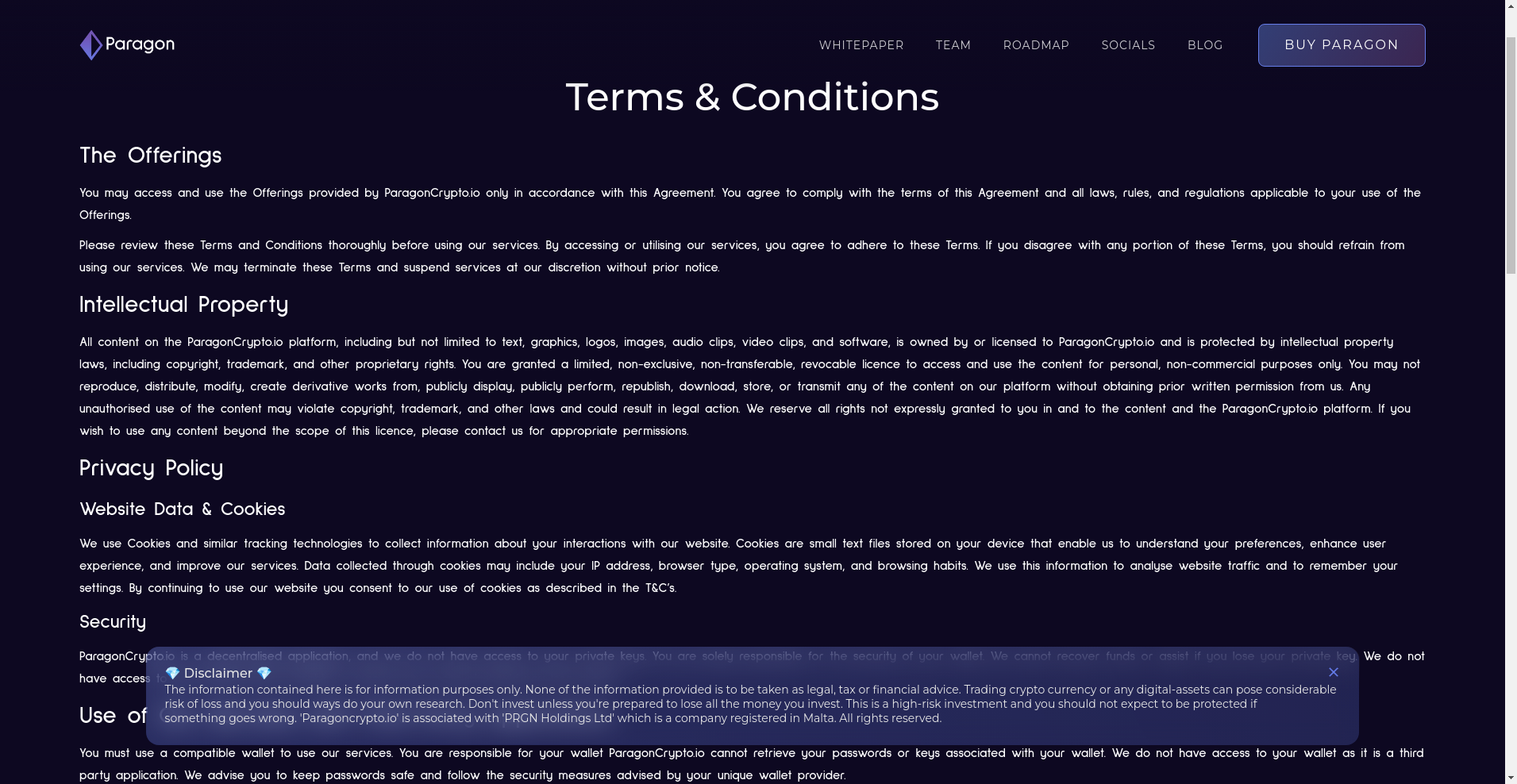Paragon ($PRG) Review: A Data-Driven Analysis of Its Legitimacy and Risks

What Is Paragon: An Introduction
Paragon is a blockchain project focused on enhancing financial privacy through innovative security technologies and privacy-centric payment solutions. It aims to become a leading platform for private transactions, emphasizing user control over digital data and transactions on the blockchain.
Developed with a mission to facilitate secure, private, and compliant crypto payments, Paragon plans to integrate privacy-enabling features into everyday financial interactions. Its ecosystem includes a proposed digital payment card capable of contactless transactions and redistributing a portion of transaction fees back to token holders—potentially creating passive income streams. This functionality is similar to models seen in some smart rewards frameworks, though specific details on distribution mechanics require further clarification.
This article provides an impartial, evidence-based assessment of Paragon’s claims, team credibility, security posture, tokenomics, and overall potential to inform investors or users evaluating its legitimacy and risk profile.
The Team and Vision Behind Paragon
The project presents itself with a fully doxxed team, notably led by CEO and Founder Robert Foster, who brings a background as a solicitor at a top UK law firm and subsequent entrepreneurial ventures. Foster’s profile suggests a combination of legal acumen, business experience, and a focus on privacy and cybersecurity, reinforcing the project’s emphasis on regulatory compliance and security.
The roadmap indicates ambitious milestones, including token launch, security audits, app development, and integration of a GBP stablecoin. These are structured across quarters, reflecting planning toward real-world adoption and technological evolution. The mention of a GBP stablecoin indicates a potential future expansion into providing more traditional fiat-pegged options within DeFi, similar to explorations discussed in articles about integrating GBP stablecoins into DeFi.
Key milestones from their roadmap include:
- Q3 2024: Early pre-sale phase targeting initial supporters
- Q1 2025: Conducting security audits and launching the token
- Q2 2025: Introduction of the Paragon Privacy Payment App v1
- Q3 2025: Upgraded app version and GBP stablecoin release
- Q4 2025: Development of a private blockchain infrastructure
While the team’s transparency and detailed roadmap are positive indicators, the project’s ability to deliver on these promises remains to be seen, especially given the competitive and regulatory complexities of privacy-based payment solutions.
Assessing the Security and Integrity of Paragon
The security analysis for Paragon relies on a comprehensive audit report from Cyberscope, the sole available major audit source. The audit assesses the project’s smart contract security, focusing on token sale mechanisms and core protocols. Understanding Cyberscope's audit methodology is key to interpreting these findings accurately.
Key findings from the Cyberscope audit include:
- Security Score: 94.08% — indicating a high level of technical security and robust code practices.
- Major vulnerabilities: Noted two high-criticality issues during the audit, both addressed or in the process of remediation. The nature of these 'major vulnerabilities' is important to understand in the context of broader critical vulnerabilities in smart contract audits.
- Code controls: Incorporation of OpenZeppelin's SafeERC20 library for secure token handling and Chainlink's price feeds to prevent manipulation during token sale pricing.
- Centralization concerns: Audit indicates primarily multisig control over critical functions, with some risk if multisig keys are compromised. This highlights potential multisig security risks in crypto that investors should be aware of.
Overall, the security assessment appears strong, but the presence of high-criticality issues—though addressed—still warrants cautious observation. Reliance on external or future security audits, transparency about fixes, and ongoing monitoring are crucial for substantiating security claims.
A Breakdown of Paragon Tokenomics
The economic model of Paragon is pivotal in understanding its long-term viability and potential risks. Although detailed tokenomics data were limited, available information suggests the following structure:
- Token Symbol: PRG (as per their slug and audit data)
- Total Supply: Not explicitly specified but implied to be fixed or capped; ongoing or future minting is not clear, raising questions about inflation control.
- Utility: The token is intended for use within the ecosystem, including transaction fee redistribution, governance, and participation in the privacy payments platform. This utility could be further enhanced by the project's proposed Privacy Payment App.
- Token Allocation:
- Team & Advisors: Estimated significant allocation with vesting schedules (details not fully disclosed)
- Pre-sale & Community: Presumed allocated to early supporters, with vesting to prevent immediate dumps
- Developer & Ecosystem Reserve: Likely a portion reserved for future development and partnerships
- Vesting & Lock-ups: Not fully detailed, but transparency is essential to prevent market manipulation or sudden sell-offs.
- Economic Risks: Without transparent supply mechanics and clear vesting schedules, investors face potential inflationary risks or dilution.
Given the inherent volatility and lack of detailed economic metrics, investors should approach PRG tokenomics with caution. Sustainable token models balance utility with controlled supply, which remains somewhat ambiguous here.
Assessing Paragon's Development and Ecosystem Activity
Reviewing the project’s development activity reveals steady progress reflected in the audit timelines and planned app releases. The developers have conducted external security audits, an important step in building credibility and ensuring platform safety.
However, there is limited evidence of actual market activity—no reported trading volume or exchange listings at this stage, which suggests the project is still in the development or pre-launch phase. The social following (around 965 followers on Twitter) and community engagement appear organic but modest, indicative of a niche or emerging project rather than a mass-market disruptor.
While development milestones are promising, absence of real-world usage data or growth metrics suggests that broader ecosystem traction remains future-facing. The focus seems to be on app/product development rather than immediate adoption. This lack of current market presence can be a red flag, especially when considering signs of crypto project abandonment, though it may simply indicate an early stage of development.
What Investors Should Know About Paragon's Terms
Paragon’s terms of use and legal disclosures are contained within comprehensive Terms & Conditions, emphasizing a high-risk investment environment. Key points include:
- High-Risk Warning: Clear statements that trading carries significant risk, and no guarantees are offered.
- No Financial or Legal Advice: The platform specifies that users should conduct their own due diligence, highlighting the speculative nature. This aligns with general advice for those engaging with DeFi activities or early-stage projects.
- Security Responsibilities: The platform does not have access to private keys; users are fully responsible for their wallet security.
- Third-Party Data and Privacy: Paragon disclaims responsibility for third-party privacy practices or data handling, focusing user attention on individual security measures.
- Liability Limitations: The platform explicitly limits liability and disclaims warranties, aligning with typical high-risk crypto project disclosures.
There are no glaring or unusual clauses that significantly differ from standard industry practices, but the inherent high-risk risk disclaimers and responsibility disclaimers highlight the need for cautious engagement.
Final Analysis: The Investment Case for Paragon
In sum, Paragon presents itself as a privacy-focused project with a credible team, structured roadmap, and positive security audit results. Its emphasis on privacy, security, and compliance aligns with industry needs, and its security posture appears robust based on available audits.
Nonetheless, several notable risks and uncertainties remain:
-
Pros / Strengths
- Fully doxxed and experienced leadership, including a legal background
- High security rating from Cyberscope audit
- Explicit focus on privacy, security, and regulatory compliance
- Developing tangible products such as a privacy payment app and private blockchain
- Transparent disclaimers emphasizing user responsibility and high risk
-
Cons / Risks
- Limited publicly available market activity, trading volume, or exchange listings
- Unclear detailed tokenomics, including supply caps and vesting schedules
- Potential centralization risks tied to multisig control
- Dependence on future technical delivery and regulatory developments
- High risk typical of early-stage projects in a competitive sector
Investors should interpret Paragon as an emerging project with promising foundational elements but with significant risks that warrant cautious engagement. Its long-term success hinges on technological execution, regulation navigation, and community adoption. As always, diligent research and risk management are imperative before involvement.

Olivia Lewis
Sociotechnical Systems Analyst
I analyze the intersection of social networks and blockchain systems. I use data to expose how scammers manipulate communities with bots, FUD, and engineered hype.
Similar Projects
-
GetRichQuick ($RICH)
GetRichQuick ($RICH) Review: Is This Crypto Project a Scam or Legit?
-
AADEX Finance
AADEX Finance Review | Is This Crypto Project a Scam or Legit? Cryptocurrency Scam Checker & Comprehensive Review
-
GalaxyHub AI
GalaxyHub AI Review | Crypto Scam Checker & Project Scam Review
-
ONI.exchange
Comprehensive Review of ONI.exchange: Is This Crypto Project a Scam? | Crypto Scam Checker & Review
-
MBXAU
In-Depth Review of MBXAU Crypto Project: Scam Checker & Detailed Analysis